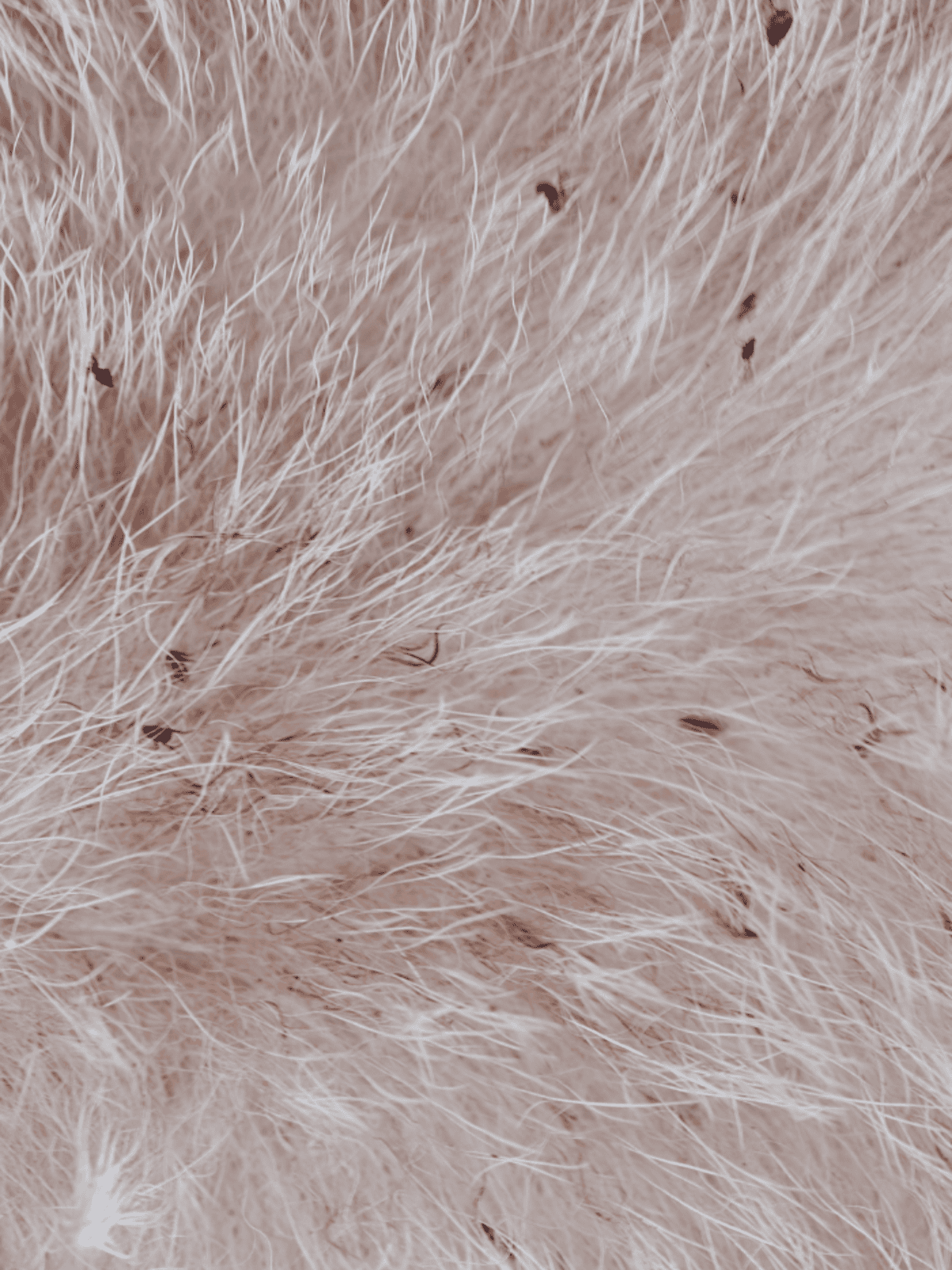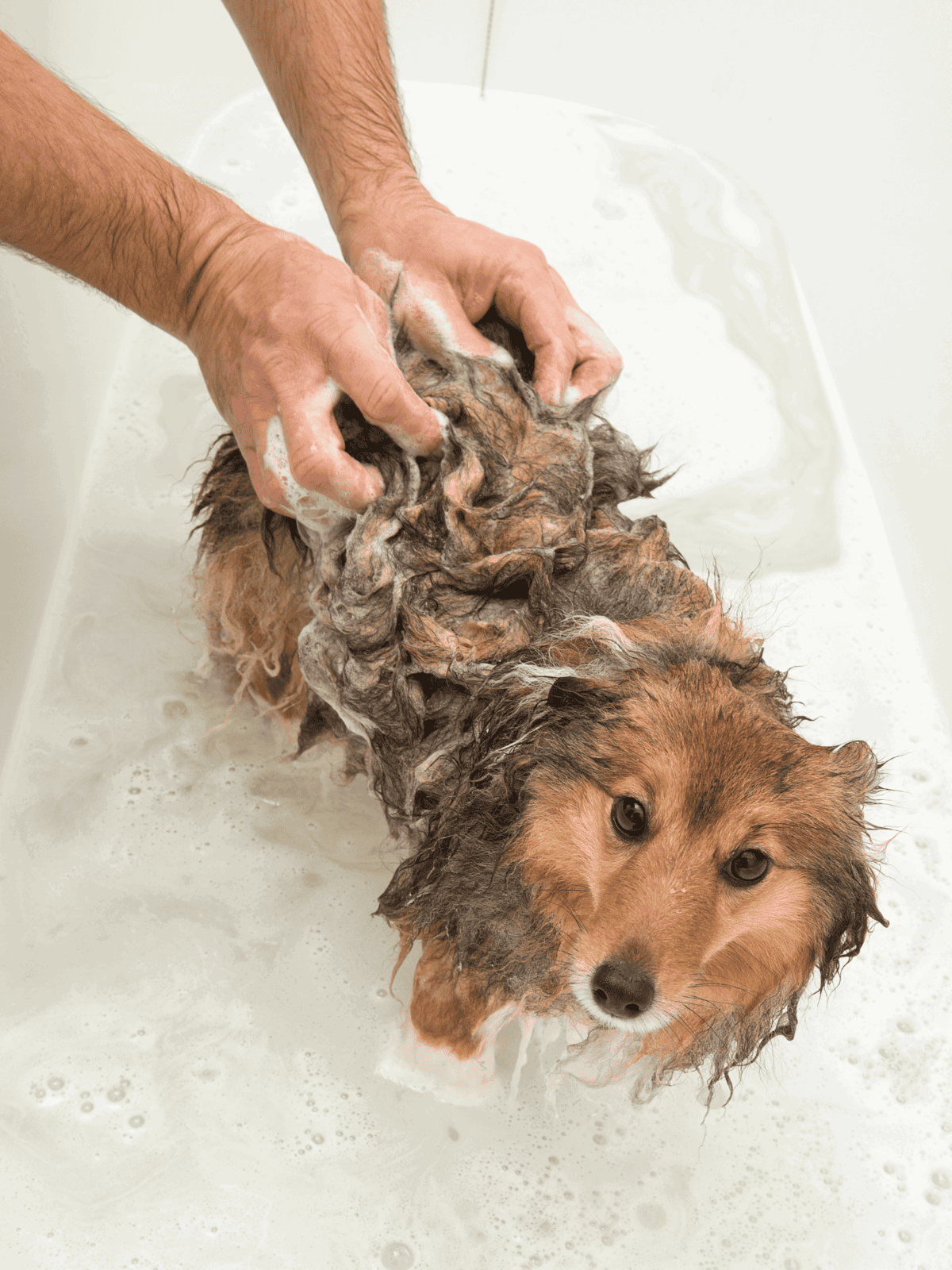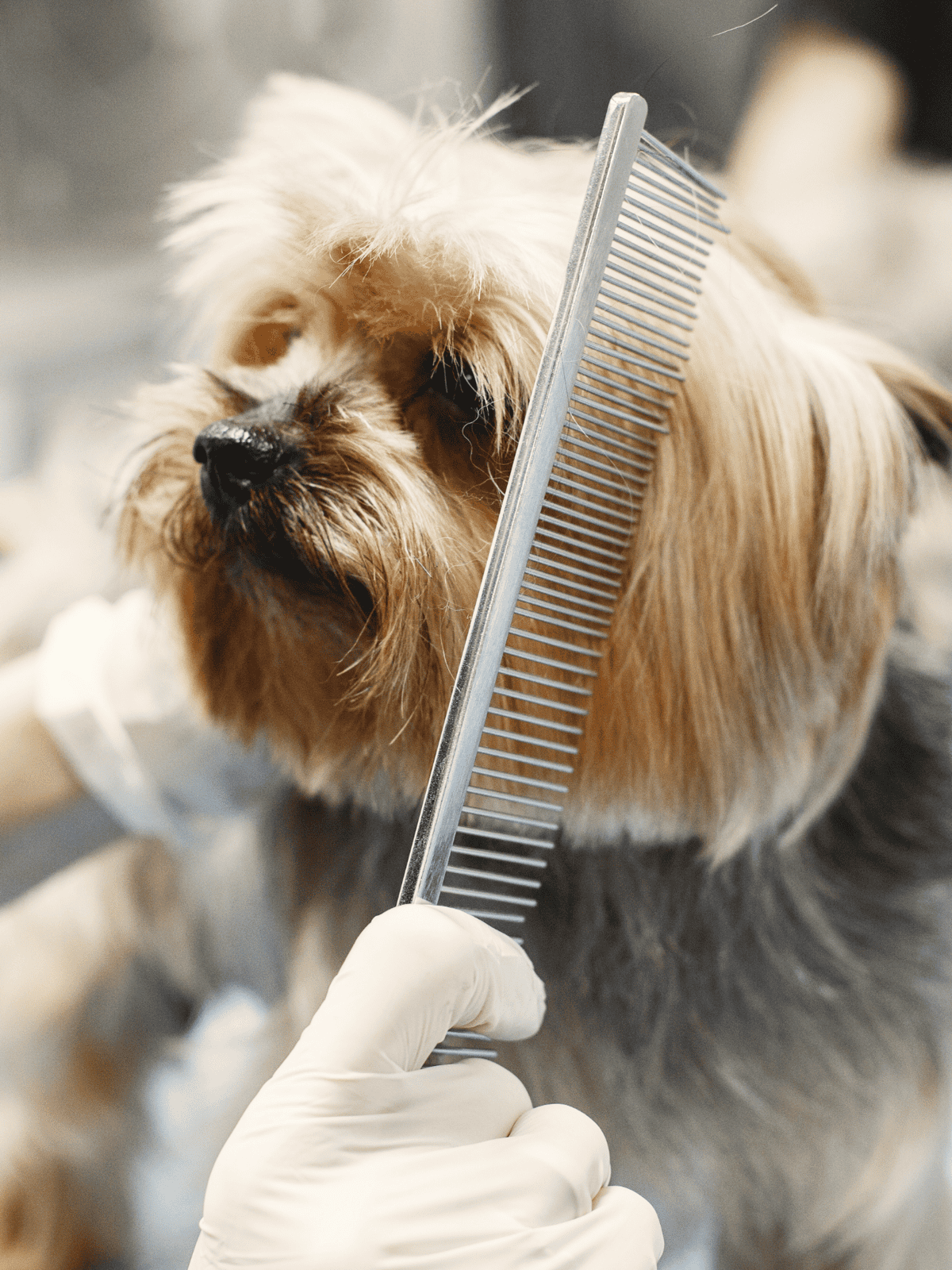How To Handle Fleas on Dogs
Fleas, despite their small size, can create significant problems once they enter a home. These tiny, wingless insects thrive by feeding on the blood of their hosts, leading to severe itching and discomfort for both humans and pets.

Fleas do more than just cause irritation. These parasites can spread dangerous diseases to various animals, including humans, and can lead to serious health issues for dogs. Effective flea control involves a thorough, multi-step process, including medication, bathing, and extensive cleaning.
Understanding Fleas on Dogs
Fleas are small, wingless insects that can cause a lot of discomfort to dogs. They not only cause itching but can also lead to serious health issues.
Flea Life Cycle
Fleas go through four stages: egg, larva, pupa, and adult. Adult fleas lay eggs on the dog’s fur, which then fall off into the environment. These eggs hatch into larvae and live in carpets, bedding, or grass.

The larvae spin cocoons and develop into pupae. When conditions are right, the pupae turn into adult fleas. This cycle can take anywhere from two weeks to several months. Understanding this cycle is key to breaking the infestation.
Signs of Flea Infestation

The most common sign of fleas is constant scratching. Dogs may also have red bumps or patches of irritated skin. Another sign is seeing fleas or flea dirt, which looks like tiny black specks, on the dog’s fur.
Flea dirt is actually flea faeces. It turns red when you add water, as it is made from digested blood. If your dog shows any of these signs, a flea infestation is likely.
Health Risks of Fleas

Fleas can cause serious health problems for dogs. Flea bites can lead to allergic reactions, causing intense itching and skin infections. They can also transmit tapeworms if the dog ingests a flea while grooming.
How To Spot Fleas on Dogs
Dogs often scratch and bite their skin when they have fleas, especially around their back and hind legs. Finding fleas on your dog can be tough because they move and jump quickly. Instead, look for signs like “flea dirt,” which is flea poop. These tiny black specks look like black pepper and are a clue that fleas have been feeding on your dog.

To search for flea dirt, use a flea comb and focus on areas like the dog’s rear end. If you find black specks, it’s likely flea dirt. At this point, it’s important to call the vet and start flea medication.
Flea Signs Checklist

Fleas can be identified by a few telltale signs. Watch for scratching and biting, particularly around your dog’s backside and hind legs, as this is a common indicator of fleas. Another sign is the presence of flea dirt, which appears as tiny black specks resembling pepper on the skin.
To check for fleas, you’ll need a few tools: a flea comb, a bright light to help spot the specks more easily, and a white paper or cloth to catch and examine any flea dirt combed out from your pet’s fur.
Start combing your dog’s fur with a flea comb. Tap the comb on the white paper to see the specks. Flea dirt will look like little black dots. This method helps to confirm if fleas are the issue.
Noticing these signs early can help address the problem quickly and make your dog comfortable again.
Enjoying this read?
We publish this content for free to generate interest in our Premium members' area. By subscribing, you can ask the writer any questions related to pet care and this article, get access to 100+ Premium Pet Care Guides and go Ad-Free with DogFix Premium for $2.99.
How To Get Rid of Fleas Quickly
Flea Combs
An effective medication can start killing adult fleas in hours, but daily checks with a fine-toothed metal flea comb are necessary to remove fleas at all stages of their life cycle. This is not like regular brushing; the goal is to knock off the parasites. Use the flea comb in the bathtub to wash away flea eggs and dirt.

Dip the comb into soapy water after every few strokes to drown any fleas or eggs. For severe infestations, continue sessions with the flea comb to ensure all eggs are removed. Ask a vet for guidance on comb usage and scheduling.
Flea Medicines

Various flea medications can kill fleas on a pet. These come in different forms, and some protect against other parasites like ticks, heartworms, hookworms, and tapeworms. A vet can recommend the best medicine based on the dog’s health, size, and infestation level.
Oral Flea Pills

Oral prescription flea prevention is highly recommended for dogs. These chewable pills work quickly, usually within 30 minutes to a few hours. Monthly preventative products that also guard against ticks are available.
A vet can help choose an oral flea and tick medicine to keep fleas away and protect against tick-borne illnesses. For quick treatment when needed, Capstar® and Advantus® are available without a prescription. These work fast but only kill adult fleas, so monthly prevention is still necessary.
Flea Liquids

Liquid flea and tick preventions applied topically can also be effective. These applications take between 12–48 hours to start killing fleas and are applied to the back of the dog’s neck to avoid ingestion. Allow the medicine to dry fully before letting the dog interact with other pets or small children.
Some topical treatments, like Frontline Plus®, are available over the counter, but prescription options such as tend to be more effective.
Natural Flea Pills and Treatments

Avoid natural or homoeopathic flea treatments as they are not proven to work and can be dangerous. There are no natural products that prevent fleas on dogs. Some flea medications are derived from natural molecules found in dirt.
Pet owners wanting a more natural option should consult their vet to see what options are suitable for their dog.
Dog Flea Shampoos and Sprays

Prescription medicines can be combined with flea shampoos and sprays to control an active flea problem and provide quick relief. During a bath, use a flea comb to remove flea dirt or eggs. Medicated flea shampoos kill fleas instantly but don’t offer lasting protection.
Combining a prescription oral flea medicine with a medicated shampoo or spray can provide immediate relief and long-term prevention. Soothing oatmeal shampoos may be as effective and less harsh on the skin than flea shampoos.
Applying Flea Treatments
Applying flea treatments to dogs involves following specific steps and taking safety measures to ensure the treatment is effective and safe for your pet.
Step-by-Step Guide

- Choose the Right Product: Select a flea treatment that’s appropriate for your dog’s size, age, and health condition. Consult with a veterinarian if unsure.
- Read Instructions Carefully: Before applying, read the product instructions. This helps you understand how much and where to apply the treatment.
- Prepare the Dog: Make sure your dog is calm. You might want to have treats ready as a reward after application.
- Application Spot: Typically, flea treatments are applied on the back of the dog’s neck, where they can’t lick it off. Part the fur so the skin is visible.
- Apply the Medication: Squeeze the recommended amount directly onto the skin. Do not rub it in.
- Monitor the Dog: Keep an eye on the dog for a few hours after application to ensure there is no allergic reaction and to prevent them from licking the area.
Safety Precautions

- Check for Allergies: Before applying any treatment, ensure your dog isn’t allergic to the ingredients. Test a small amount if necessary.
- Use Gloves: Wear gloves during application to avoid direct contact with the medication.
- Keep it Away from Children and Other Pets: Store the treatment out of reach and apply it in a controlled setting where other pets and children are not present.
Flea bites can cause itching and discomfort. Some dogs might even develop an allergy to flea saliva, leading to more severe symptoms.
Treating Flea Bites
To treat flea bites, first, clean the affected area with mild soap and water. Cool compresses can help reduce swelling and itching. Apply an over-the-counter hydrocortisone cream to soothe the skin.

Keep the dog from scratching or biting the bites, as this can lead to infections. Consider using an Elizabethan collar for a few days. For severe cases, consult a veterinarian for prescription medications to reduce inflammation and discomfort.
Dealing with Flea Allergy Dermatitis
Flea Allergy Dermatitis (FAD) is a common issue in dogs allergic to flea saliva. Symptoms include intense itching, redness, and hair loss. Begin by giving your dog monthly flea preventatives and thoroughly cleaning their environment — bedding, carpets, and upholstery.

If your dog shows signs of FAD, a vet can prescribe oral antihistamines or corticosteroids to control itching and reduce inflammation. In severe cases, specialised allergy injections might be necessary.
From cleaning bites to managing allergies, prompt action can relieve your dog’s discomfort and prevent complications.
Monitoring and Assessing Treatment Efficacy
To ensure that a flea treatment is working, it’s important to monitor your dog’s condition closely and assess the effectiveness of the treatment. Keeping track of progress and knowing when to seek veterinary care are crucial steps.
Tracking Progress
Start by maintaining a daily log of your dog’s condition. Note any changes in behaviour, scratching, licking, or visible fleas. Weekly checks can help you see if the treatment is reducing flea numbers.

Use a flea comb to check for fleas and flea dirt. Regular baths can also reveal if fleas are still present. If you see fewer fleas over time, the treatment is working.

Weighing your dog regularly can also help. Weight loss may indicate that the dog is still stressed by fleas. In any case, a noticeable improvement in behaviour usually means the treatment is effective.

Important signs that indicate progress in flea treatment include a noticeable decrease in scratching, fewer live fleas visible on your pet, and an overall improvement in the condition of their coat.
When to Seek Further Veterinary Care
If there’s no improvement after a few weeks, consult your vet. Some treatments might not work on all fleas due to resistance. Multiple treatments or a different medication might be needed.

Allergic reactions, like excessive itching or rash, are reasons to see the vet immediately. Also, if your dog shows signs of infection such as red skin, swelling, or pus, get professional help right away.
Conditions like flea allergy dermatitis require medical attention. Vets can prescribe medications to manage symptoms and recommend alternative treatments.
Always consult a vet before changing treatments, especially if your dog has other health issues.
Treating the Home for Fleas
Removing fleas from the house involves several days of thorough cleaning. Vacuuming each area of the home is crucial. Focus on upholstered furniture, like couches and chairs, as well as mattresses, floors, carpets, rugs, and baseboards. Vacuuming helps remove flea eggs and dirt that fall from pets and get into tiny crevices. Always empty the vacuum into a sealed bag and dispose of the waste outside, far from the home.

Using room sprays, powders, and other flea-eliminating products along with medications can be very effective. Make sure to choose products that are safe for pets when treating both the home and yard. Additionally, pet bedding needs frequent washing in hot water, and it should be dried on high heat or placed in direct sunlight. This will help in killing any remaining fleas and their eggs. Regular cleaning and proper disposal of waste are key to effectively eradicating fleas from the living space.
Preventing Fleas on Dogs
Preventing fleas on dogs starts with regular monthly preventative medication. This medication continuously protects your pet from the inside out. Dogs need year-round flea, tick, and heartworm medicine to keep them safe from these pests. Even if fleas are more common in warmer seasons, vets recommend flea and tick prevention throughout the year.

Some dogs are prone to allergic reactions to flea bites, known as flea allergy dermatitis. To determine the best type of flea and tick prevention for your dog, it’s important to speak with a vet. They can provide recommendations suited to your dog’s specific needs.
Steps to Prevent Fleas:
- Administer monthly preventative medication.
- Keep your dog on a year-round flea and tick preventive.
- Consult your vet to find the best prevention plan.
Using preventative measures reduces the need for battling flea infestations, which can be time-consuming and difficult. Regular treatments reduce the chances of eggs hatching and re-infesting your home. By keeping up with these measures, dog owners can ensure a flea-free environment for their pets.
Educating About Fleas
Fleas can cause serious health issues for dogs and their owners. Understanding how to prevent and treat infestations is essential for keeping pets healthy.
Sharing Information with Pet Owners
Educating pet owners about fleas helps prevent outbreaks. Fleas are small, wingless insects that feed on blood. They can cause itching, allergic reactions, and even transmit diseases.

Owners should know that fleas thrive in warm, humid environments. Weekly grooming and regular vacuuming help reduce flea populations. Using flea preventatives, like collars and spot-on treatments, is critical.
Using a flea comb can help detect fleas early. Teach owners to look for flea dirt, which looks like black specks on the dog’s skin. If you find fleas, act quickly with appropriate treatments.
Community Efforts to Control Fleas
Community action is crucial to controlling fleas. Flea infestations can spread easily in parks, neighbourhoods, and pet facilities.

Local veterinary services can offer workshops or distribute informational pamphlets about flea prevention. Pet owners should be encouraged to work together to keep shared spaces flea-free.
Encourage monthly treatments for all pets in a given area. Neighbours should communicate about any flea outbreaks to address the problem promptly. Prevention is more effective when everyone participates. Regular checks and consistent, community-wide efforts can make a big difference.
